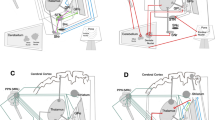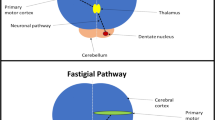Abstract
The pathophysiological mechanisms of essential tremor (ET) are still not entirely clear. In the present study, we aimed to investigate the cerebello-thalamo-cortical connectivity in ET using the cerebellar continuous theta burst stimulation (cTBS) and possible effects on tremor and reaching movements. Sixteen patients with ET and 11 healthy subjects underwent two experimental sessions: (i) cTBS over the right cerebellar hemisphere (real cerebellar cTBS) and (ii) cTBS over the neck muscles (sham cerebellar cTBS). The two sessions were performed at least 1 week apart. The effects of real and sham cerebellar cTBS were quantified as excitability changes on contralateral primary motor cortex, as well as possible changes of postural tremor and reaching movements on the ipsilateral arm. Primary motor cortex excitability was assessed by recording the input/output curve of the motor-evoked potentials from the right first dorsal interosseous muscle. Tremor was rated clinically. Objective assessment of tremor and reaching movements was performed using kinematic techniques. Real cerebellar cTBS reduced the excitability in the contralateral primary motor cortex in healthy subjects though not in patients with ET. There was no significant change in tremor severity and reaching movements, as assessed by clinical examination or kinematic techniques, after real or sham cerebellar cTBS in patients with ET. Finally, there was no correlation between individual changes of M1 excitability and kinematic measures of tremor and reaching movement abnormalities in patients with ET. The results suggest that functional cerebello-thalamo-cortical connectivity tested by cTBS is abnormal in ET and that cerebellar cTBS does not ameliorate tremor in this condition.




Similar content being viewed by others
Abbreviations
- AMT:
-
Active motor threshold
- ANOVA:
-
Analysis of variance
- CTC:
-
Cerebello-thalamo-cortical
- cTBS:
-
Continuous theta burst stimulation
- EMG:
-
Electromyographic
- ET:
-
Essential tremor
- FTM:
-
Fahn-Tolosa-Marin
- FDI:
-
First dorsal interosseous
- I/O:
-
Input–output
- LTD:
-
Long-term depression
- MSO:
-
Maximal stimulator output
- MEP:
-
Motor-evoked potential
- M1:
-
Primary motor cortex
- rTMS:
-
Repetitive transcranial magnetic stimulation
- RMT:
-
Resting motor threshold
References
Deuschl G, Bain P, Brin M. Consensus statement of the Movement Disorder Society on Tremor. Ad hoc scientific committee. Mov Disord. 1998;13 Suppl 3:S2–S23.
Bain P, Brin M, Deuschl G, Elble R, Jankovic J, Findley L, et al. Criteria for the diagnosis of essential tremor. Neurology. 2000;54 Suppl 4:S7.
Elble RJ. Diagnostic criteria for essential tremor and differential diagnosis. Neurology. 2000;54 Suppl 4:S2–6.
Deuschl G, Bergman H. Pathophysiology of nonparkinsonian tremors. Mov Disord. 2002;17 Suppl 3:S41–8.
Elble R, Deuschl G. Milestones in tremor research. Mov Disord. 2011;26:1096–105.
Helmich RC, Toni I, Deuschl G, Bloem BR. The pathophysiology of essential tremor and Parkinson's tremor. Curr Neurol Neurosci Rep. 2013;13:378.
Deuschl G, Wenzelburger R, Löffler K, Raethjen J, Stolze H. Essential tremor and cerebellar dysfunction clinical and kinematic analysis of intention tremor. Brain. 2000;123:1568–80.
Helmchen C, Hagenow A, Miesner J, et al. Eye movement abnormalities in essential tremor may indicate cerebellar dysfunction. Brain. 2003;126:1319–32.
Herzog J, Hamel W, Wenzelburger R, et al. Kinematic analysis of thalamic versus subthalamic neurostimulation in postural and intention tremor. Brain. 2007;130:1608–25.
Kronenbuerger M, Konczak J, Ziegler W, et al. Balance and motor speech impairment in essential tremor. Cerebellum. 2009;8:389–98.
Fasano A, Herzog J, Raethjen J, et al. Gait ataxia in essential tremor is differentially modulated by thalamic stimulation. Brain. 2010;133:3635–48.
Groppa S, Herzog J, Falk D, Riedel C, Deuschl G, Volkmann J. Physiological and anatomical decomposition of subthalamic neurostimulation effects in essential tremor. Brain. 2014;137:109–21.
Passamonti L, Cerasa A, Quattrone A. Neuroimaging of essential tremor: what is the evidence for cerebellar involvement? Tremor Other Hyperkinet Mov (N Y). 2012; 2. pii: 02-67-421-3.
Bhalsing KS, Saini J, Pal PK. Understanding the pathophysiology of essential tremor through advanced neuroimaging: a review. J Neurol Sci. 2013;335:9–13.
Kronenbuerger M, Gerwig M, Brol B, Block F, Timmann D. Eyeblink conditioning is impaired in subjects with essential tremor. Brain. 2007;130:1538–51.
Shill H, De La Vega F, Samanta J, Stacy M. Motor learning in essential tremor. Mov Disord. 2009;24:926–8.
Vallence AM, Ridding MC. Non-invasive induction of plasticity in the human cortex: uses and limitations. Cortex. 2014;58:261–71.
Koch G, Mori F, Marconi B, et al. Changes in intracortical circuits of the human motor cortex following theta burst stimulation of the lateral cerebellum. Clin Neurophysiol. 2008;119:2559–69.
Popa T, Russo M, Meunier S. Long-lasting inhibition of cerebellar output. Brain Stimul. 2010;3:161–9.
Hoffland BS, Bologna M, Kassavetis P, et al. Cerebellar theta burst stimulation impairs eyeblink classical conditioning. J Physiol. 2012;590:887–97.
Li Voti P, Conte A, Rocchi L, et al. Cerebellar continuous theta-burst stimulation affects motor learning of voluntary arm movements in humans. Eur J Neurosci. 2014;39:124–31.
Gironell A, Kulisevsky J, Lorenzo J, Barbanoj M, Pascual-Sedano B, Otermin P. Transcranial magnetic stimulation of the cerebellum in essential tremor: a controlled study. Arch Neurol. 2002;59:413–7.
Avanzino L, Bove M, Tacchino A, et al. Cerebellar involvement in timing accuracy of rhythmic finger movements in essential tremor. Eur J Neurosci. 2009;30:1971–9.
Popa T, Russo M, Vidailhet M, et al. Cerebellar rTMS stimulation may induce prolonged clinical benefits in essential tremor, and subjacent changes in functional connectivity: an open label trial. Brain Stimul. 2013;6:175–9.
Gironell A, Martínez-Horta S, Aguilar S, Torres V, et al. Transcranial direct current stimulation of the cerebellum in essential tremor: a controlled study. Brain Stimul. 2014;7:491–2.
Manto M, Bower JM, Conforto AB, et al. Consensus paper: roles of the cerebellum in motor control—the diversity of ideas on cerebellar involvement in movement. Cerebellum. 2012;11:457–87.
Fahn S, Tolosa E, Marin C. Clinical rating scale for tremor. In: Jankovic J, Tolosa E, editors. Parkinson’s disease and movement disorders. Baltimore: Williams and Wilkins; 1993. p. 271–80.
Rossi S, Hallett M, Rossini PM, Pascual-Leone A, Safety of TMS Consensus Group. Safety, ethical considerations, and application guidelines for the use of transcranial magnetic stimulation in clinical practice and research. Clin Neurophysiol. 2009;120:2008–39.
Currà A, Modugno N, Inghilleri M, Manfredi M, Hallett M, Berardelli A. Transcranial magnetic stimulation techniques in clinical investigation. Neurology. 2002;59:1851–9.
Sturman MM, Vaillancourt DE, Metman LV, Bakay RA, Corcos DM. Effects of subthalamic nucleus stimulation and medication on resting and postural tremor in Parkinson's disease. Brain. 2004;127:2131–43.
Koekkoek SK, Hulscher HC, Dortland BR, et al. Cerebellar LTD and learning-dependent timing of conditioned eyelid responses. Science. 2003;301:1736–9.
Kotani S, Kawahara S, Kirino Y. Purkinje cell activity during learning a new timing in classical eyeblink conditioning. Brain Res. 2003;994:193–202.
Axelrad J, Louis E, Honig L, et al. Reduced Purkinje cell number in essential tremor—a postmortem study. Arch Neurol. 2008;65:101–7.
Louis ED, Kuo SH, Vonsattel JP, Faust PL. Torpedo formation and Purkinje cell loss: modeling their relationship in cerebellar disease. Cerebellum. 2014;13(4):433–9.
Hellriegel H, Schulz EM, Siebner HR, Deuschl G, Raethjen JH. Continuous theta-burst stimulation of the primary motor cortex in essential tremor. Clin Neurophysiol. 2011;123:1010–5.
Chuang WL, Huang YZ, Lu CS, Chen RS. Reduced cortical plasticity and GABAergic modulation in essential tremor. Mov Disord. 2014;29:501–7.
Grimaldi G, Argyropoulos GP, Boehringer A, et al. Non-invasive cerebellar stimulation—a consensus paper. Cerebellum. 2014;13:121–38.
Chen R. Repetitive transcranial magnetic stimulation as a treatment for essential tremor? Clin Neurophysiol. 2012;123:850–1.
Conflict of Interest
The authors report no financial interests or potential conflicts of interest.
Author information
Authors and Affiliations
Corresponding author
Electronic Supplementary Material
Below is the link to the electronic supplementary material.
Supplementary Table 1
Repeated measure ANOVA on reaching movement kinematics. Significant effects are bold type printed. (DOCX 27 kb)
Rights and permissions
About this article
Cite this article
Bologna, M., Rocchi, L., Leodori, G. et al. Cerebellar Continuous Theta Burst Stimulation in Essential Tremor. Cerebellum 14, 133–141 (2015). https://doi.org/10.1007/s12311-014-0621-0
Published:
Issue Date:
DOI: https://doi.org/10.1007/s12311-014-0621-0




